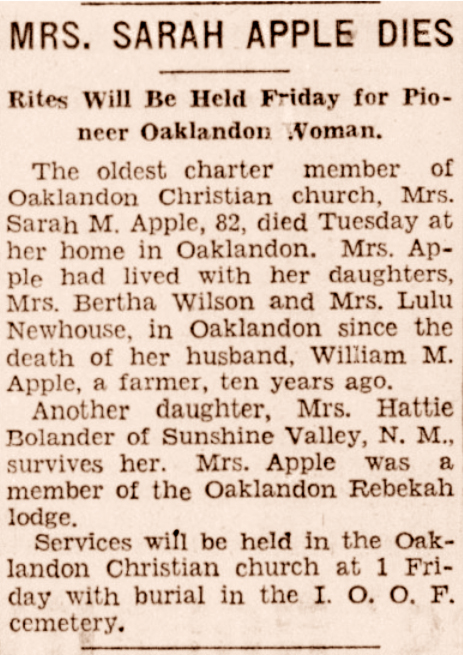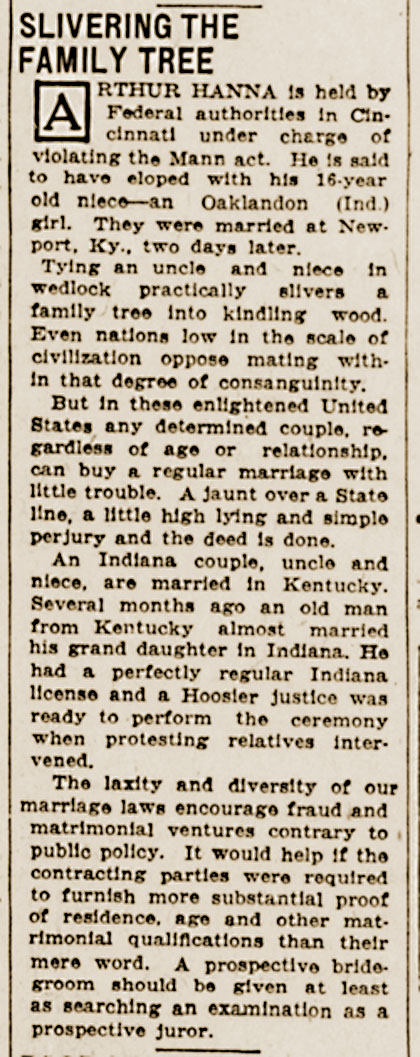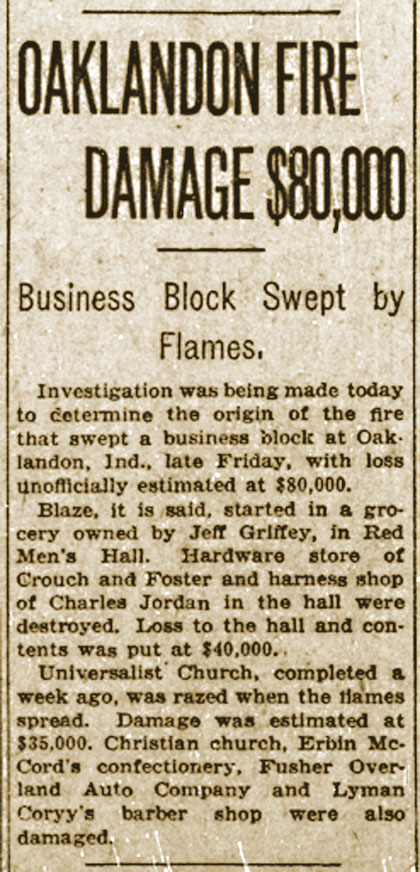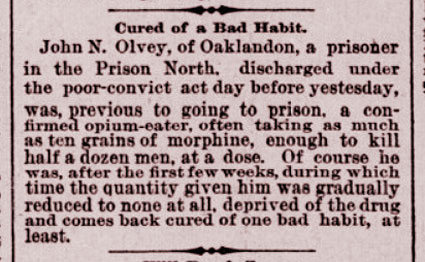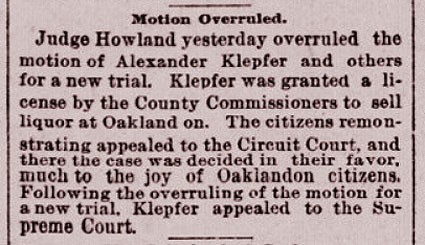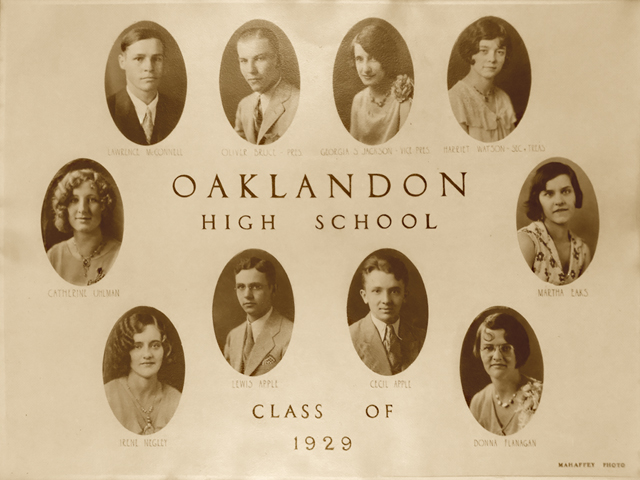Who's Online
User Functions
Welcome to Oaklandon, Anonymous Tuesday, January 13 2026 @ 08:08 pm EST
History
Mrs. Sarah Apple Dies

- Monday, April 28 2025 @ 05:32 am EDT
-
- Contributed by:
- Mike
-
- Views:
- 222
- Comment (0)
- Trackbacks (0)
Slivering The Family Tree

- Monday, February 28 2022 @ 08:30 am EST
-
- Contributed by:
- Mike
-
- Views:
- 1,200
- Comment (0)
- Trackbacks (0)
OAKLANDON FIRE DAMAGE $80,000

- Monday, February 28 2022 @ 08:16 am EST
-
- Contributed by:
- Mike
-
- Views:
- 1,600
- Comment (0)
- Trackbacks (0)
Oaklandon found in Sports Illustrated

- Tuesday, February 15 2022 @ 05:41 am EST
-
- Contributed by:
- Mike
-
- Views:
- 1,228
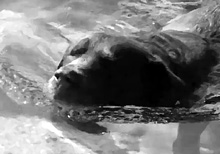 When searching reference materials for anything related to Oaklandon, I came across a mention in Sports Illustrated 08/26/1968, Vol. 29, Issue 9, Letter From The Publisher. By Garry Valk. In the article the author shares his thoughts on the periodical's letter-writing readers and refers to a letter received from a 12 year old named Clarke Hemphill with a suggestion for some unique sports coverage for the magazine:
When searching reference materials for anything related to Oaklandon, I came across a mention in Sports Illustrated 08/26/1968, Vol. 29, Issue 9, Letter From The Publisher. By Garry Valk. In the article the author shares his thoughts on the periodical's letter-writing readers and refers to a letter received from a 12 year old named Clarke Hemphill with a suggestion for some unique sports coverage for the magazine:
- Trackbacks (0)
The Ghost of an Oaklandon Murder

- Monday, February 07 2022 @ 06:30 am EST
-
- Contributed by:
- Mike
-
- Views:
- 1,482
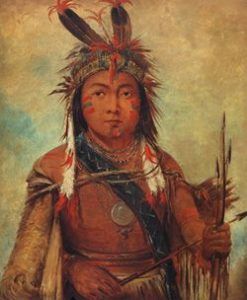 Several years ago while searching out historical information pertaining to the Town of Oaklandon, I came across a reference to "the murder of an Algonquin in Oaklandon," sometime in the 1830's, (see "More on Germantown") as being the precipitating event which resulted in the exodus of Oaklandon's Germanic residents, who, moving farther north, established the community of Germantown in the year 1834.
Several years ago while searching out historical information pertaining to the Town of Oaklandon, I came across a reference to "the murder of an Algonquin in Oaklandon," sometime in the 1830's, (see "More on Germantown") as being the precipitating event which resulted in the exodus of Oaklandon's Germanic residents, who, moving farther north, established the community of Germantown in the year 1834.
As referenced in our post "Ask A Librarian", Librarian Andrea Glenn, Indiana Division, Indiana State Library was unable to immediately verify a source for information regarding the supposed murder; she was however, able to find this information recounted in the 2008 book "Ghost Hunter's Guide to Indianapolis" by Lorri Sankowsky and Keri Young.
In Chapter 10, entitled "Indy's Nefarious Neighborhoods," under the section on "Geist Reservoir," the following excerpt (used with permission) does indeed seem to bolster the account:
Germantown was located near what is now the Bridgewater neighborhood. It was established in 1834 as the result of a murder. An Algonquin Indian was murdered in the nearby town of Oaklandon. The German immigrants were so disturbed by the incident that they formed their own community on the northern banks of Fall Creek. The main street of Germantown is now the entrance road to the Geist Sailing Club.
ÂÂÂ
Life was good in the ill-fated town. Residents were content with their diminutive community. There was a general store, post office, shoemaker, furniture factory, church, and grist mill surrounded by small farms. There were also a handful of larger estates, consisting of vast barns, several outbuildings, miles of wooden fences, and nice homes.
ÂÂÂ
The citizens of Germantown were outraged as the water company took over their town, buying what land they could and forcefully taking land from those who resisted. They had no recourse against the water company, and soon their sleepy little town was deconstructed, acre by acre. Helplessly they stood back and watched as the redirected water flooded the valley and engulfed life as they knew it.
While not exactly adding to the known details of that macabre tale of murder in Oaklandon from long ago; Lorri does go on to remind us that "Geist" - the current name of the second-largest man-made lake in Indiana - is also the German word for Ghost!
I find it important to mention here that our friendly Ask-A-Librarian also pointed out that according to History of Indianapolis and Marion County, Indiana, Part 2, by Berry Robinson Sulgrove; "The Sulgrove book listed the date March 1, 1834 for when John, Solomon, and George Beaver platted Germantown. I was able to find that plat recorded in the Marion County Deed Book D, page 427. The Sulgrove history goes on to list June 18, 1849 as the date that John Emery platted Oakland. This makes the story from the Ghost Hunter's Guide contradictory, if Oakland was platted/founded after Germantown."
Upon further investigation I came across an "History of Geist Reservoir and Germantown." This I found on the (now defunct) website, LogCabinVet.com (see Germantown - Our Historic Neighbor) it relays the very same information. I suspect this compiled history may actually be the source for the accounts of the founding of Germantown and its relation to Oaklandon. More research is certainly needed to settle the matter.
It is hoped that in the persuit of facts relating to the storried death of this - as of yet un-named - Algonquin Person, somewhere in the annuls of Oaklandon history, we may continue to be aided in our efforts to keep alive the colorful history of our pleasent little community.
- Comment (0)
- Trackbacks (0)
Cured of a Bad Habit.

- Wednesday, August 25 2021 @ 06:16 am EDT
-
- Contributed by:
- Mike
-
- Views:
- 1,437
- Comment (0)
- Trackbacks (0)
Motion Overruled.

- Wednesday, August 25 2021 @ 05:56 am EDT
-
- Contributed by:
- Mike
-
- Views:
- 1,143
- Comment (0)
- Trackbacks (0)
MISSION OF CHRISTIAN PEOPLE

- Wednesday, August 25 2021 @ 05:10 am EDT
-
- Contributed by:
- Mike
-
- Views:
- 1,385
- Comment (0)
- Trackbacks (0)
Class of 1929 - Oaklandon High School

- Friday, August 20 2021 @ 03:55 am EDT
-
- Contributed by:
- Mike
-
- Views:
- 1,433
I once again find myself in the role of de-facto historian for all things Oaklandon...
In an email recieved from Gail Wisehart I learned that she had a picture "found when cleaning out my parents house in McCordsville" that featured the Oaklandon High School Class of 1929. Not wishing this obvious historical piece to go to waste, she asked if we would like to take possession; of course I was quite interested.
Making the 30 mile trek to recover this artifact was well worth the journey. The item was an 11" X 14" framed print featuring the ten individuals making up the class.
I managed a fairly decent photo-copy of the print and gladly share it here. The highest resolution is available in 4160px X 3120px ".TIF" file format using [THIS LINK].
An interesting side-note: upon closer inspection, handwriting on the reverse suggests that this photograph was originally the possession of Lawrence McConnel (pictured), purchased from Mahaffey Photo for the princely sum of 85 cents. In addition, the framed photograph was backed with a section of the May 15, 1933 edition of The Indianapolis News with a picture of Fay Wray "prepared to face the summer suns in her white spectator sports ensemble with its smart cape."
You will find detail images of each person featured below.
Click on each picture to enlarge...
- Comment (0)
- Trackbacks (0)
Oaklandon High School 1940 Year Book

- Thursday, August 19 2021 @ 01:09 am EDT
-
- Contributed by:
- Mike
-
- Views:
- 1,254
I happed upon* the 1940 edition of "The Oak" Year Book for Oaklandon High School. This is a very entertaining look at life in Oaklandon in what may well be considered its heyday.ÂÂ
In addition to providing the solution to the "Weaver" mystery [see: 1914 IHSAA BOYS STATE T&F MEET] it also provided me with an opportunity to learn the esoteric technique of embedding a PDF document into a blog post.
Please enjoy strolling (scrolling) the halls of 1940's Oaklandon High School in the Year Book below. As an added bonus, there is an autograph page in the back of the book with many notable signatures ;)
*original pdf found at The Archive.org website [https://archive.org/details/oak1940oakl]
CLICK HERE to download this copy for viewing in your favorite PDF Viewer
- Comment (0)
- Trackbacks (0)



